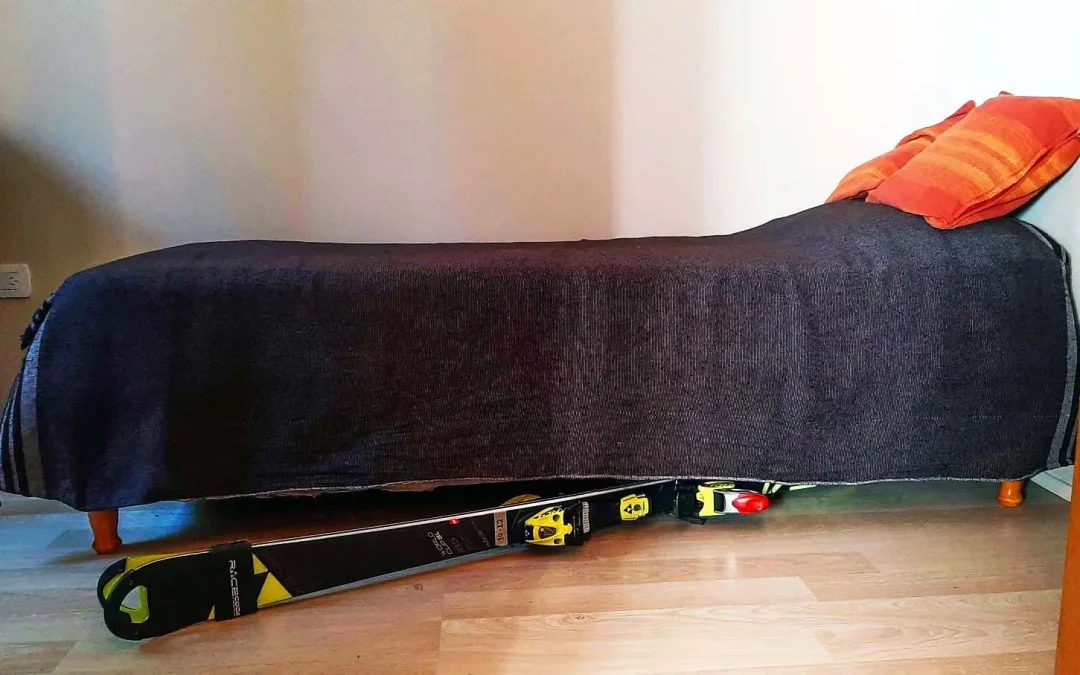When the season is over, or if you are not going to ski again for a certain amount of time (several weeks/months), it is key to follow some steps to preserve and extend the life of your gear. The equipment, particularly in skiing, is crucial. This is a quick -yet complete- and easy guide you can follow up to preserve your gear.
Skis
1) Clean and dry them out completely. ski gear storage
2) Inspect for repairs to do at the base, top sheet, and edges. Check the top sheets for damage. Gummy stone for taking out the rust in the bevels is very important. One tip on preventing rusting: when we finish each ski day, we must let the skis dry out completely, apart from each other (never put the straps right after you stop skiing because they trap the moisture and can rust the edges in the places where the straps are placed).
3) Strong (3-times the regular amount) waxing without scrapping to isolate the base. Use an all-temperature (AKA “universal”) or a softer warm-weather wax. This heavy coat of wax protects the base from “drying out” during summer and losing its wax absorbing capacity. Before using the skis again, make a pass with the iron to soften the old wax, and scrape it all off while it’s still warm. Then wax again with new wax and scrape…
4) Store them in the natural position, with straps not too tight, laying on their sides. Because skis have profliles (camber and rocker), you need to ensure that they aren’t compressed at all. That could deform and change the designed profile for that ski. So try not to place the straps too tight nor leave the skis landing flat on their bases. The easiest solution is often just storing them on their sides and sliding them under the bed (as in this post’s featured image).
The camber profile distributes your weight more evenly throughout the whole length of the ski. If you don’t have any camber on your skis, there’s more pressure on the middle of the ski which makes it more difficult to turn and control, particularly on the groomers or on hard snow. Also, the camber allows the ski to have more rebound at the end of the turn, like we tipically find in Slalom racing skis.
On the other side, the more rocker a ski has, the more it will naturally float in soft snow.
5) Store in a cool dry place (out of direct sunlight that can damage the top sheets). If you have to store them in the garage, elevate the skis off of the cement floor. Best not to store skis in a bag.
_For transportation: the skis should be wrapped around with four ski straps (two at the shovels and two at the tails) to prevent rubbing and scratching each other. IMPORTANT: the two main straps must be placed tightly right in the place where the two shovels (and the two tails) contact their bases with each other. Furthermore, the remaining two straps placed near the bindings must be loose enough. This is to make sure the straps do not distort the natural curvature of the ski (camber and rocker profiles). In high-level skiing, every detail matters…

Bindings
1) Check binding screws and tighten if needed. On skis with a riser plate, we must remove the bindings and first tighten the screws that secure the plate to the ski.
2) Document the DIN settings in use, of both bindings. I recommend writing it down on tape and sticking it to the shovel of the ski.
3) Back off the DIN scale to the lowest release/retention setting (but not less than that, because there is a risk of spring losing). Relaxing the spring tension while they are in storage is key to extending the life of your bindings.
4) Lock the heel in the up (closed) position, so the spring stays unloaded (compressed).
Boots
1) Completely dry out them, removing the boot liner from the outer shell, and then put them together again.
2) Check all the screws (cuff and buckles), and tighten up any loose ones as needed.
3) Check the soles of your boots for wear, and replace them if needed/possible. Prevent unwanted wear to the bottom of your boots by always attaching Cat Tracks before walking. Walking with these protectors is easier and safer too.
4) Make sure the tongue is in the correct position and buckle the boots back up with low tension (but not so loose that they unbuckle themselves) for storage. This is done so the plastic shell keeps its shape (remember plastic has “memory”), and also prevents the buckles from catching on everything.
5) Store in a cool dry place.
IMPORTANT: all screws loosen with time and/or use. Always readjust all of them (ski plate/bindings & boots) before the ski season. See you on the slopes!
IMPORTANT: all screws loosen with time and or use. Always readjust all of them (ski plate/bindings & boots) before the ski season.
Keep ripping some arcs!
If you find this piece of information useful to improve your skiing, please support this website and help us to keep it up and create more content! A small donation really means a lot to us... Thank you so much!


Recent Comments